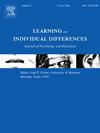The longitudinal contribution of working memory and visuomotor integration to early and developing handwriting fluency
IF 9
1区 心理学
Q1 PSYCHOLOGY, EDUCATIONAL
引用次数: 0
Abstract
Acquiring fluent handwriting in the first school years is crucial for academic achievement as attentional resources become available for more complex tasks. Yet, the role of cognitive and motor processes in developing handwriting fluency (as opposed to handwriting products) remains unclear. Therefore, this study investigated the longitudinal effects of working memory and visuomotor integration on handwriting fluency (number of inversions in velocity, pen stops, and pen lifts) in 364 children in their first year of handwriting tuition (Mage = 7.0 years) at three measurement points. We used cross-lagged structural equation models. Results revealed that handwriting fluency becomes independent of working memory early in development. Further, handwriting fluency predicted visuomotor integration skills, while visuomotor integration did not predict handwriting fluency. These findings imply that handwriting becomes independent early, and yields benefits for visuomotor integration, highlighting the relevance of early handwriting practice.
Educational relevance statement
In our study on early handwriting development, we found that a child's previous handwriting fluency (i.e., pen movement fluency) strongly predicts their current handwriting fluency. While factors like working memory and visuomotor integration are linked to handwriting fluency, they do not necessarily contribute to its improvement over time. This highlights the importance of consistent handwriting practice and educational interventions to enhance handwriting fluency at the beginning of school. Moreover, fostering handwriting fluency can also potentially payback for developing fundamental motor skills (i.e., visuomotor integration).
工作记忆和视觉运动整合对早期和发展中书写流畅性的纵向影响
在第一学年获得流利的书写对学业成就至关重要,因为注意力资源可以用于更复杂的任务。然而,认知和运动过程在发展书写流畅性(相对于书写产品)中的作用仍不清楚。因此,本研究在三个测量点上调查了364名儿童在书法教学第一年(年龄= 7.0岁)的工作记忆和视觉运动整合对书写流畅性(速度反转次数、停笔次数和举笔次数)的纵向影响。我们使用了交叉滞后结构方程模型。结果显示,书写流畅性在发育早期就独立于工作记忆。此外,书写流畅性预测视觉运动整合能力,而视觉运动整合能力并不预测书写流畅性。这些发现表明,书写在早期就变得独立,并有利于视觉运动的整合,突出了早期书写练习的相关性。在我们对早期书写发展的研究中,我们发现一个孩子以前的书写流畅性(即笔的运动流畅性)强烈地预测了他们现在的书写流畅性。虽然工作记忆和视觉运动整合等因素与书写流畅性有关,但它们并不一定会随着时间的推移而提高。这突出了持续的书写练习和教育干预在学校开始时提高书写流畅性的重要性。此外,培养书写流畅性也可以潜在地回报发展基本的运动技能(即视觉运动整合)。
本文章由计算机程序翻译,如有差异,请以英文原文为准。
求助全文
约1分钟内获得全文
求助全文
来源期刊

Learning and Individual Differences
PSYCHOLOGY, EDUCATIONAL-
CiteScore
6.60
自引率
2.80%
发文量
86
期刊介绍:
Learning and Individual Differences is a research journal devoted to publishing articles of individual differences as they relate to learning within an educational context. The Journal focuses on original empirical studies of high theoretical and methodological rigor that that make a substantial scientific contribution. Learning and Individual Differences publishes original research. Manuscripts should be no longer than 7500 words of primary text (not including tables, figures, references).
 求助内容:
求助内容: 应助结果提醒方式:
应助结果提醒方式:


